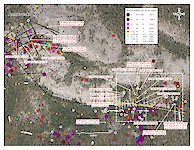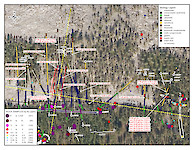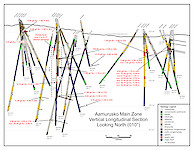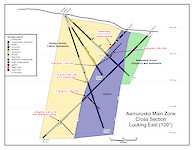Aurion Identifies Possible High Grade Mineralized Shoot at Aamurusko
Aurion Resources Ltd. (TSX VENTURE:AU) (“Aurion” or the “Company”) is pleased to provide an update on drilling results at Aamurusko on its Risti Project in northern Finland.
Highlights
- 17.1 g/t Au over 1.80 m in drillhole 75, 80 m down plunge of drillhole 42 (789 g/t Au over 2.9 m)
- 2.0 m of an 8.2 m wide vein in drillhole 77 contained visible gold (assays pending) 25 m up plunge of hole 42
- Gold mineralization with an apparent steeply dipping shoot geometry has been intersected in 5 drillholes over a down plunge distance of 110m at Aamurusko
- There is likely a periodicity to these shoots as the boulder field has > 1.5 km of east-west strike
- Drilling with a track mounted rig can successfully target this mineralization
- Drilling has stopped for the holiday season break and will continue in January
- Please follow the link to a table, maps and sections on our website:
Summary
High grade mineralization predictably intersected in several drillholes may define a coherent zone/shoot comprised of at least two primary auriferous vein sets filling the space of the shoot. The shoot can also be envisioned as a zone that has a narrow horizontal dimension (strike) but with a long and steep plunge lying on the northern contact between the gabbro and the clastic sediments in an inflection (dilation zone) along the contact caused by faulting/shearing. The width and strike length of the shoot are not known at this time.
The identification of a shoot-like geometry linking intercepts in holes 77-42-51-54-75 is an exciting development as mineralized shoots tend to be vertically continuous for long distances down plunge and are expected features in orogenic gold systems.
The gabbro sill remains a principal focus for targeting gold mineralization over a distance of > 1.3 km at Aamurusko to Aamurusko Northwest, however, gold mineralization has been encountered in clastic sediments to the north of the gabbro, at the north and south contact of the gabbro and in the volcanics to the south.
Drilling from the south using a track mounted rig has successfully intersected high grade mineralization and can thus increase our drilling flexibility while reducing our cost in testing the Aamurusko target.
Aamurusko Drilling Multiple zones of gold mineralization have now been identified at Aamurusko. Three zones over >300 m strike length are currently known at the main Aamurusko target area. Mineralization was also identified >700 m to the northwest.
Multiple zones of gold mineralization have now been identified at Aamurusko. Three zones over >300 m strike length are currently known at the main Aamurusko target area. Mineralization was also identified >700 m to the northwest.
Two drillholes designed to test an apparent, steep plunge of mineralization as defined by the high-grade intersections in drillholes AM18042 and 51 (which assayed 789.0 g/t Au over 2.9 m and 17.46 g/t Au over 1.1 m respectively), intersected gold bearing quartz veins both up plunge and down plunge. Drillhole AM18075 intersected quartz veins assaying 17.06 g/t Au over 1.80 m near the gabbro-sediment contact 80 m down plunge of AM18042. Further downhole another vein zone was intersected assaying 4.56 g/t Au over 3.65 m, including 29.2 g/t Au over 0.50 m.
Drillhole AM18077 intersected an 8.2 m wide quartz vein zone (core length) at the gabbro-sediment contact approximately 25 m up plunge of AM18042. The upper 2.0 m of the vein contained 18 specks of visible gold (assays are pending). 
The intercepts in drillholes AM18042, 51, 54, 75 and 77 line up along an azimuth of 010 degrees over a distance of approximately 50 m horizontally and 100 m sub-vertically along the gabbro-sediment contact. These drill intercepts may partially define a mineralized shoot with an apparent steep (70-80 degrees?) plunge to the north-northeast (approx. azimuth 010 degrees). The mineralization is open in all directions. The width of the shoot is not known at this time.
Approximately 75 m to the west, narrow gold bearing quartz veinlets were intercepted in several drillholes entirely hosted in clastic sediments. Assays of 4.22 g/t Au over 1.00 m, 6.46 g/t Au over 1.00 m and 4.95 g/t Au over 1.00 m were returned from drillholes AM18056, 61 and 63, respectively.
 Drillholes AM18075, AM18076 and AM18077 were drilled from south to north utilizing a track mounted drill rig.
Drillholes AM18075, AM18076 and AM18077 were drilled from south to north utilizing a track mounted drill rig.
Drillhole AM18064 intersected quartz-sulfide veining assaying 13.7 g/t Au, 43.2 g/t Ag, 1.89% Pb and 1.48% Zn over 0.6 m at the very bottom of the drillhole at the southern sheared contact of the gabbro. Unfortunately, this hole was terminated in mineralization. Similar mineralization which assayed 1.83 g/t Au, 32.5 g/t Ag, 1.99% Pb and 1.98% Zn over 0.32 m was intersected in drillhole AM18032 approximately 38 m to the east-southeast.
Drillhole AM18062 designed to undercut the high-grade mineralization in AM18035 (12.45 g/t Au over 5.2 m) intersected 2.48 g/t Au over 2.5 m including 7.83 g/t Au over 0.55 m. Structural measurements indicate that the mineralization in these holes trends NNE-SSW.
 Drillhole AM18068 located 25 m south of the main slope break and drilled to the south intersected a 3.5 m wide zone of quartz-carbonate-sulfide stringers hosted by mafic volcanics. The zone assayed 0.58 g/t Au over 3.5 m including 2.11 g/t Au, 100 g/t Ag, 2.00% Pb, 1.42% Cu and 0.45% Cu over 0.50 m.
Drillhole AM18068 located 25 m south of the main slope break and drilled to the south intersected a 3.5 m wide zone of quartz-carbonate-sulfide stringers hosted by mafic volcanics. The zone assayed 0.58 g/t Au over 3.5 m including 2.11 g/t Au, 100 g/t Ag, 2.00% Pb, 1.42% Cu and 0.45% Cu over 0.50 m.
A total of 64 drillholes testing multiple target areas were completed since July 2018 for total meterage of approximately 10,000 m. Assays are pending for 9 drillholes at Aamurusko.
Comment
“The predicted auriferous vein intercepts in drillholes 75 and 77 have greatly enhanced our understanding of the structural controls at Aamurusko. The discovery of gold mineralization in trenching and drill core in multiple targets over a distance of more than 8 km suggests the mineralizing system at Aamurusko and Risti in general may have considerable scale. Almost every drillhole to date at Risti has encountered some gold mineralization, supporting this. Moreover, we have encountered gold mineralization in multiple host rocks including clastic sediments north of the gabbro contact, the gabbro itself and volcanics to the south. Both gabbro contacts host high grade shear hosted vein mineralization and with the intercept in AM18068 there is potential for the discovery of other veins through the >1.4 km long high grade boulder field,” commented Mike Basha, President and CEO. “Furthermore, there are many targets over >15 km of strike across Risti currently being developed for drill testing. Aurion is well funded to advance the Aamurusko discovery and the Risti Project into the foreseeable future”.
Background
The geological setting of the Risti project has many similarities to prolific gold-rich orogenic gold belts globally, specifically the Timmins camp of the Abitibi province of Northern Ontario. The Aamurusko zone appears to be underlain by young unconformable clastic rocks (meta-sandstones and conglomerates) of the Kumpu Group. These Kumpu Group conglomerates resemble the Timiskaming conglomerates of the Timmins and Kirkland Lake area of the Abitibi province and occur in a similar geo-tectonic setting (both represent the youngest stratigraphic sequence within their respective belts). The Kumpu Group and the Timiskaming group were deposited in late orogenic extensional basins. They form in relation to major movement along regional faults or deformation zones. In the Abitibi province, many high-grade, multimillion-ounce gold deposits are temporally and spatially associated with the Timiskaming conglomerates (or their equivalents) in close proximity to major regional deformation (fault) zones such as the Porcupine-Destor or Cadillac Lake-Larder Lake deformation zones. The Kumpu Group appears to have been deposited in a similar geological setting adjacent to the Sirkka shear zone, which is a major deformation zone in the Central Lapland Greenstone Belt. Strong alteration including fuchsite, tourmaline, iron carbonate, albite and quartz veining is seen along the entire length of this structure.
Quality Assurance and Control
All samples were delivered to ALS Minerals preparation facility in Sodankyla, Finland where sample preparation work was completed. All analytical work was completed at ALS Minerals facility in Loughrea, Ireland. ALS Minerals is an internationally accredited lab and are ISO compliant (ISO 9001:2008, ISO/IEC 17025:2005). All samples were analyzed for gold using the Au-AA26 procedure (50g fire assay with AAS finish: Lower Detection Limit 0.01 g/t gold; Upper Limit – 100 g/t gold). Any samples that returned overlimit values (>90.0 g/t gold) or had visual indication of mineralization, such as visible gold or prospective vein intervals (>90.0 g/t gold) were analyzed by Au-SCR24 1kg, Screen Fire Assay Au (0.05-1,000 ppm) by 1kg screen fire assay (50g nominal sample weight). The sample pulp (1kg) is passed through a 100 micron stainless steel screen. Any material remaining on the screen (>100 micron) is retained and analyzed in its entirety by fire assay with gravimetric finish and reported as the Au (+) fraction. The material passing through the screen (<100 micron) is homogenized and two sub-samples are analyzed by fire assay with AAS finish. The average of the two AAS results is taken and reported as the Au (-) fraction result. All three values are used in calculating the combined gold content of the plus and minus fractions. The gold values for both the (+) 100 and (-) 100 micron fractions are reported together with the weight of each fraction as well as the calculated total gold content of the sample.) Multi-element analysis (ME-ICP61, four-acid digestion, 35 element ICP-AES) was completed on all samples. Certified standards and blanks were inserted every 30 samples. ALS has its own QA/QC protocol using standards, blanks and duplicates.
Mike Basha, P.Eng., P.Geo., President and CEO of Aurion, a Qualified Person as defined by National Instrument 43-101, is responsible for the preparation of this release. For more information on these projects please visit our website at www.aurionresources.com.
Forward-Looking Statement
Certain statements contained in this release constitute forward-looking information. These statements relate to future events or future performance. The use of any of the words “could”, “intend”, “expect”, “believe”, “will”, “projected”, “estimated” and similar expressions and statements relating to matters that are not historical facts are intended to identify forward-looking information and are based on the Companies’ current belief or assumptions as to the outcome and timing of such future events. Actual future results may differ materially. The forward-looking information contained in this release is made as of the date hereof and Aurion is not obligated to update or revise any forward‑looking information, whether as a result of new information, future events or otherwise, except as required by applicable securities laws. Because of the risks, uncertainties and assumptions contained herein, investors should not place undue reliance on forward‑looking information. The foregoing statements expressly qualify any forward‑looking information contained herein.
On behalf of the Board of Directors,
Michael Basha, Chief Executive Officer
Neither the TSX Venture Exchange nor its Regulation Services Provider (as that term is defined in the policies of the TSX Venture Exchange) accepts responsibility for the adequacy or accuracy of this release.
